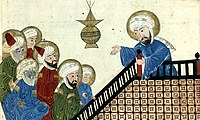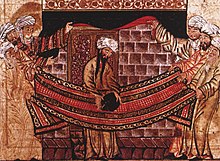| Revision as of 15:27, 5 March 2007 editALM scientist (talk | contribs)Extended confirmed users, Pending changes reviewers7,390 edits Remove the picture from the lead per WP:NPOV#undue_weight. It is not against WP:NOT#censored and saying that is against WP:AGF.← Previous edit | Revision as of 15:31, 5 March 2007 edit undoTom harrison (talk | contribs)Administrators47,534 edits restore pictureNext edit → | ||
| Line 7: | Line 7: | ||
| Edit image details between this line --> | Edit image details between this line --> | ||
| ].{{Ed right2|Muhammad/images|section=1}}]] | ].{{Ed right2|Muhammad/images|section=1}}]] | ||
| ] by ].<ref>{{cite web | publisher=] | url=http://expositions.bnf.fr/livrarab/grands/0_01.htm | title=Le Prophète Mahomet | publication=L'art du livre arabe | accessdate=03-02-2007}}</ref> "Muslims generally have a strong aversion to sculptured or pictured representations of their Prophet."<ref>{{cite web | url=http://www.supremecourtus.gov/about/north&southwalls.pdf | title=Courtroom Friezes: South and North Walls (Information Sheet) | publisher=Office of the Curator, Supreme Court of the United States | accessdate=03-02-2007}}</ref> Therefore, Islamic art tended to be abstract or decorative or calligraphic, although there are portraits of Muhammad drawn by Muslim artists.<ref>{{cite news | url=http://news.bbc.co.uk/2/hi/middle_east/4674864.stm | title=BBC Q&A: Depicting the Prophet Muhammad | publisher=BBC News | date=02-02-2006}}</ref><ref>Esposito (1998), p.9</ref><ref>{{cite web | url=http://hnn.us/roundup/entries/21534.html | publisher=History News Network | title=Islam prohibits neither images of Muhammad nor jokes about religion | author=Amir Taheri | accessdate=03-02-2007}}</ref>{{Ed right2|Muhammad/images|section=1}}]] | |||
| <!-- and this line --> | <!-- and this line --> | ||
| <includeonly>}}</includeonly><!-- | <includeonly>}}</includeonly><!-- | ||
Revision as of 15:31, 5 March 2007
Image(s) 1

Image(s) 2
Image(s) 3

- "Le Prophète Mahomet". Bibliothèque nationale de France. Retrieved 03-02-2007.
{{cite web}}: Check date values in:|accessdate=(help); Unknown parameter|publication=ignored (help) - "Courtroom Friezes: South and North Walls (Information Sheet)" (PDF). Office of the Curator, Supreme Court of the United States. Retrieved 03-02-2007.
{{cite web}}: Check date values in:|accessdate=(help) - "BBC Q&A: Depicting the Prophet Muhammad". BBC News. 02-02-2006.
{{cite news}}: Check date values in:|date=(help) - Esposito (1998), p.9
- Amir Taheri. "Islam prohibits neither images of Muhammad nor jokes about religion". History News Network. Retrieved 03-02-2007.
{{cite web}}: Check date values in:|accessdate=(help)